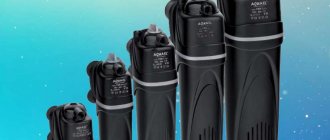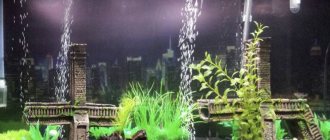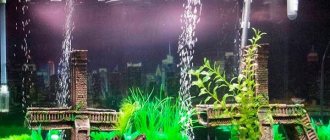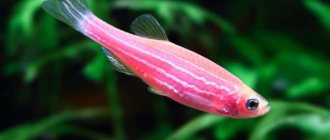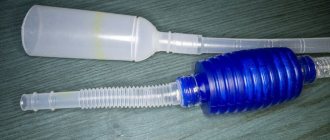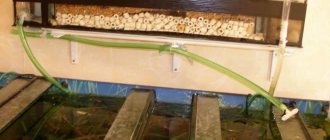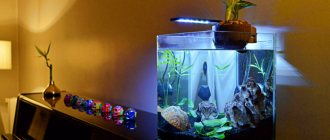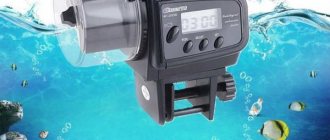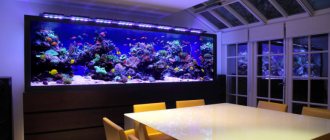What is a pump for?
A pump in an aquarium is a device that forms the flowing movement of water, saturating it with the necessary amount of oxygen. In some cases, aquarists use the device when replacing old fluid. The use of a special foam sponge makes it possible to purify water during intake and subsequent pumping of water back into the aquarium.
The pump itself consists of an electric motor with an impeller and a filter element, mounted in a sealed housing. During operation, aquarium water is drawn through the filter element, due to which the cleaning process occurs. Most modern devices have an aerator to saturate the aquatic environment with oxygen.
What is a pump for?
The world of aquarium keeping is vast and diverse, so beginners in this field are often confused when they hear how much it takes to create a home aquarium. For example, many novice aquarists do not know what an aquarium pump or water pump is - and yet, this is one of the most useful designs.
It is no secret for experienced water enthusiasts that in order to reproduce fish at home, it is necessary to supply oxygen to the reservoir. If aeration is absent or organized incorrectly, then this negatively affects the well-being and health of small pets - they get sick and die. This also leads to turbidity in the aquatic environment, the formation of an unpleasant odor and siltation of the soil. To prevent such incidents from happening, aquarists use a pump - this is what a pump is for.
Water pumps perform the following main functions in tanks:
- Contributes to the purity of the aquatic environment.
- They ensure the saturation of the liquid with oxygen and the movement of flows, which helps eliminate the film on the surface and equalizes the temperature regime.
- They decorate the appearance of the tank - air bubbles rising to the surface give the aquarium a catchy and bewitching look.
- They increase soil flow, which prevents rotting of the substrate.
The role of pumps in the world of aquarium farming is enormous, since only with this device can oxygen be supplied to the aquarium at night. During the day, this is not so important, since plants produce oxygen, but at night, excess carbon dioxide is formed in reservoirs. Installing a pump in your aquarium can solve this problem. In addition, if the structure of the device has a foam sponge, then the structure can also replace the filter.
In what cases is a pump needed:
- Reservoir overpopulation.
- The aquarium model is narrow and deep.
- There are no living plants in the container.
- Biofiltration of water is disrupted.
- The aquarium is equipped with a tightly closing protective cover.
What types are there
The designs of operating devices have several varieties. These include piston or diaphragm models. Piston engines last much longer and are more powerful. The downside is that they make a lot of noise and vibration. They are recommended to be installed in containers larger than 200 liters. Membrane equipment consumes less electricity, produces less noise, but operates in small containers of up to 150 liters. There are several options for installing equipment:
- Internal (submersible).
- External mounting method.
- Universal type.
The internal (submersible) pump must operate directly in the water. External mounting method involves mounting on the side of the aquarium or in an accessible place. A popular method is to install a universal type pump in the aquarium. This method allows the device to be used in various installation locations. This ensures comfortable operating conditions.
Types of pumps
Aquarium pumps differ from each other in the following characteristics:
- by type of construction;
- according to the installation method.
Let's take a closer look at the types of pumps.
By design
By design, pumps can be divided into two large groups:
- Membrane devices. An aquarium pump of this type makes virtually no extraneous sounds. Plus, it consumes little energy. But the device cannot be used for large-volume tanks. It has low productivity, and therefore is used in containers with a volume of no more than 150 liters.
- Piston devices. Much more powerful than the first type. The downside is the strong noise during operation and vibration during pumping. This device is used for large aquariums with a volume exceeding 200 liters.
You can purchase the device at any specialized store. There you can also get advice on choosing a device.
By installation type
According to the installation method, aquarium pumps are:
- Submersible or internal. Placed directly in the aquarium water. Fixed with suction cups.
- External. Attaches to the outer wall of the container. Only the device tube is placed inside. Designed for small tanks.
It is also worth choosing an external device if there are fish in the aquarium with demanding conditions. It saves space and does not create discomfort for animals.
How to install correctly
Before installation, select the model and mounting method. Many fish lovers prefer to install the pump themselves. Pumps immersed in water have clamps or suction cups. External type pumps are mounted on the body of the aquarium. Typically used in small tanks. Can be used for fish breeding.
The possibility of selecting and installing a purchased aquarium pump with your own hands is not excluded. The process does not require special knowledge. Fill the aquarium with water (at least more than half). Secure the pump with the filter at a distance of 3 centimeters from the bottom surface. Attention, it is recommended to mount the pump in the corner of the aquarium to effectively create a longitudinal jet.
Make the direction of water flow along one of the walls. If there is a need to install several pumps at once, direct the flows in different directions. Installation should be carried out with installed decorations and soil inside the aquarium. Press the suction cups onto the glass surface until completely fixed.
When the housing is completely fixed (with suction cups or a bracket), the device can be turned on. The movement of water inside the container indicates that everything was done correctly. Most modern models are attached in two ways. Vertical (overhead) or horizontal (suction cups). Attention, when choosing the second method, the vertical fasteners must be removed.
What is it, what is it for, how does it work
A filter or pump or pump is a device that pumps water. The device consists of several main parts:
- containers into which air is supplied through tubes:
- sprayers that regulate the flow;
- the motor that makes it work.
The aquarium does not have a constant flow of water, like a natural reservoir, so the water in it is not enriched with oxygen and is quickly polluted by the waste products of its inhabitants.
Pumps or pumps are designed to correct the situation.
In addition to oxygen enrichment, the devices purify water and equalize its temperature in the upper and lower layers. Another important function for many types of fish is the creation of an imitation of flow in the aquarium. It will probably be useful for you to know what items you need to purchase for your aquarium.
Operation and care
It is strictly forbidden to test the submersible pump without water (dry). It should be noted that the pump cannot be turned off for more than 12 hours. Otherwise, the nitrifying bacteria on the substrate will die, and the entire cleaning process will have to start over. And this has a detrimental effect on the living inhabitants of the aquarium.
The device of a simple compressor includes a glass with a filter element (sponge), an electric motor, and tubes for pumping water. Maintenance of any type of compressor is a simple process. Once a month, open the case and wash the foam elements from dirt. This takes 10-15 minutes. After washing the filter, bleed the system from air (remove the air plug from the tubes).
Once a year, a complete maintenance of the entire system is carried out. Pour 10-15 liters of liquid from the aquarium into a small container. Turn off the power supply, completely disassemble the filter element and other accessories, rinse everything with water. Assemble the system, carefully check connections and fastenings. Try not to let the pump stop for a long time during flushing. The permissible value in the non-operating state is 12 hours.
Homemade pump for an aquarium: pros and cons
Natural water purification is carried out by settling dirt and other trace elements on the ground. But dirt quickly accumulates there and frequent washing is necessary. Traditionally, to improve cleaning and create more comfortable conditions for fish, it is customary to use a pump with a filter.
The advantage of installing the pump yourself is the reduction in costs for the services of a specialist. Installing the filter yourself will not take much time. The pump and additional elements can be modified using any available means. The main advantages are:
- Compact, quiet operation.
- Installation of the device under specific conditions.
- Selection and own calculation of the required pump parameters.
- Affordable price of materials.
- Placing your own decorations.
The downside is the complete dismantling of the device and all decorative elements with periodic complete washing. If the calculations are incorrect, the selected filter will have insufficient water rinsing and aeration. In specific cases, there may be sloppy collection, poor quality of sealant, or an error in calculations.
Description of equipment
If in the recent past most filters only performed mechanical purification of water from suspended matter and other contaminants, today equipment of this type allows solving problems with nitrates, nitrites and ammonia, providing optimal living conditions for even the most demanding tropical fish.
The design of the aquarium filter is simple and consists of the following components:
- water pump;
- housing with filter cassettes;
- compartment with sponges and filler for biofiltration;
- taps with tubes for water inlet and outlet.
The operating principle of such equipment is extremely simple. The water pump used creates a vacuum in the suction tube, which is immersed in water. Water is supplied from the nozzle into the filter housing, which passes through the sponges and compartments with biofiltration filler, after which it is directed under pressure into the aquarium through the appropriate hose.
Today, two main types of aquarium filters have gained popularity:
- internal;
- external.
Internal ones also include bottom filter units that can be placed under the ground, which allows you to solve problems with detritus and various contaminants that accumulate in sand and small pebbles at the bottom.
External filters include classic versions with baskets and so-called backpacks, which are intended primarily for small-power aquariums and are mounted on the back wall, providing high-quality mechanical purification of water and its aeration.
What are the criteria for choosing a pump for an aquarium?
The choice of pump depends on several factors. It is necessary to decide on the type of water (sea, fresh). Pumping volumes (the larger the capacity, the stronger the pump power). Place where the aquarium is installed, bedroom, veranda, public space. The choice of equipment with low or normal noise and vibration indicators depends on this. Price and quality are considered the main indicators when choosing.
Installing a pump in an aquarium
Installation features are determined by the pump model. Depending on the type of installation, the pump is installed inside the aquarium or mounted outside, providing the pump with access to water. It is for this reason that so many aquarists prefer universal pumps: if desired and if necessary, the type of installation can be freely changed.
To secure the pump, use suction cups, clamps and other fasteners. It is important to ensure that the position of the pump does not change over time: so that it does not become loose, does not slide down, and so on. Therefore, each model is supplied with installation instructions.
Performance
A properly selected pump should show high performance. This is approximately 3-5 times the displacement of the container itself. In small containers, low-power mini-units with a throughput capacity of up to 400 l/h are used. Technical characteristics are indicated in the passport data.
Pumps from the popular company Eheim Universal, Eheim Compact and Eheim Compact + have high performance. It is 270-2280 liters/hour. The devices have power adjustment and can be used in sea or fresh water. One of the powerful options is the Resun Eco-Power EP-12000 pump, which pumps 12,000 l/h. In small containers, Resun SP 500 pumps are used. Power 5 W, capacity 200 l/h.
How to choose?
The stores offer a wide range of water pumps for the tank, so many beginners get confused and don’t know which pump to choose for the aquarium. There are several important factors to consider before purchasing a specific model.
Purpose of application
When choosing a pump, you should first decide for what purpose the design is being purchased:
- Filtration will require the use of a sponge if one is not provided by the manufacturer.
- Aeration requires a hose placed above the surface of the liquid.
- To create water flows, you need a flow pump that mixes the water layers.
- If a pump is purchased to fill a tank, you need to take into account the level of liquid rise and the drain hose.
Reservoir volume
The power of the device is selected based on the volume of the artificial reservoir. In small tanks, pumps with a capacity of up to 380 l/h are used, in medium-sized tanks - up to 600 l/h. If a giant tank of more than 500 liters is installed at home, then you will need a device with a capacity of 5000-8000 l/h. In order not to make a mistake, you can use special tables for calculating pump power.
Type and location of the aquarium
When choosing a water pump, you should also take into account the type of reservoir: for fresh water containers, designs with metal elements are purchased, for marine ones - with ceramics. In addition, you need to take into account the location of the tank, since some pumps make loud noise during operation, which causes discomfort to those people who have an aquarium in their bedroom or recreation area.
Power
The water transfer pump is constantly in operation. This means that the electric motor also rotates around the clock. This provides for certain costs of electrical energy and, accordingly, payment for it. The power consumption of the electric motor depends on the volume of pumped liquid in one hour. The stronger the water flow, the greater the motor power in W units.
For example, it pumps 350 liters of water per hour with an electric motor power of 4.5 W. It is recommended to choose pumps with low power consumption. But the calculated data must be taken into account. The comfortable environment of living organisms should not be disturbed.
Bandwidth
A homemade or factory-made pump for an aquarium must have the necessary throughput. Using this parameter, the water flow necessary to meet the physiological needs of living organisms is created. In simple words, the calculated pumping value of 100 liters of capacity is ensured by a pumping capacity of 300-500 l/h.
According to the established rules, the pump capacity must correspond to pumping five volumes of the reservoir used. According to calculations, the pump should pump 3-5 such aquariums per hour of operation. Proper circulation not only cleans the aquatic environment, but also transfers oxygen there, maintaining a comfortable microclimate for fish and other inhabitants.
Device selection
Today, manufacturers produce aquarium pumps and pumps of various models. To choose the right device correctly, you need to consider various factors . Particular attention should be paid to the technical characteristics of the equipment:
- Device type. Based on the conditions of use, they are external, submersible and universal. The first ones are fixed outside the aquarium, the second ones are under water and are more often used by aquarists. Universal devices can be installed on both sides.
- Performance. It should be at least 3 times and maximum 5 times the volume of the container. The throughput of the device is indicated in the manufacturer's technical documentation.
- Power. It is more economical to choose a water pump for an aquarium with a low power, since it works continuously, but it should be enough to make the aquatic environment in the tank comfortable.
- Material. All types of devices have a plastic case. The only difference is the raw material from which the engine axle is made. In freshwater aquariums the axis is metal, while in saltwater tanks it is ceramic.
- Noisy. Unlike a compressor, pumps are less noisy. The level of this indicator is indicated in the device passport.
You need to pay attention to device manufacturers. You should not buy cheap devices from unknown brands. As a rule, they are low-power, noisy, fail quite quickly and do not have a warranty period.
Aquarium volume
The choice of the size of the liquid container depends on the installation location, the needs of the owner, and methods of use. The volume of a homemade aquarium depends on the experience of the assembler and the degree of knowledge of the design.
The factory dimensions do not always allow the container to be installed in the desired location. A homemade version can be installed in any chosen location. The selection of volume must correspond to a pump that can provide the calculated water pumping. You can install a thermostat to maintain a certain temperature.
Popular models
Aquarium compressors have a large selection of different models. The main emphasis is on the power indicators and performance of the device. New modern designs greatly improve the aeration effects. There are models that work in all four planes (fresh, sea water; internal, external mounting). The most popular are:
- Aquael - Poland capacity from 500 to 2000 l/h.
- Juwel Eccoflow - vane pump (Germany), capacity 300-1500 l/h.
- Aqua Medic is a powerful unit for containers with salty liquid (sea water).
- AquaClear is a submersible version with compact dimensions, pumping 480-1500 l/h.
- Deltec - automatic pumps for terrariums, florariums. They work in any liquid medium, dosing, supplying fertilizers, watering vegetation.
- Tunze is a low energy consumption pump that can be used in aquariums of any level. The mount consists of a magnetic device (holder), silent, low vibration. Performs the functions of generating wave vibrations, which ensures uniform fluid circulation. Controls thermoregulation and prevents the accumulation of harmful microelements. On some models a protective grille is used.
It is necessary to select a model and accessories according to specific calculations and operating conditions of the aquarium installation.
Types of aerating devices
In the natural environment, oxygen enters the reservoir due to wind flows and water fluctuations. In a closed space, this function is performed by a pump.
Aquarium pumps are classified:
- by design components - piston (vibration) and membrane;
- by type of installation - external and submersible type.
Piston devices are durable and much more powerful than diaphragm devices, but they create more noise and vibration. It is advisable to use such a mechanism for tanks exceeding 200 liters.
In the enclosed space of the aquarium, the pump performs the function of aeration.
The main advantages of membrane devices are considered to be noiselessness and low energy consumption. But such pumps have poor performance and are used for containers up to 150 liters.
Submersible devices are secured under water with special suction cups or clamps. An external pump for an aquarium is mounted outside the tank, and air tubes are installed into the water. This option is used for small containers and for keeping particularly demanding fish. This allows you to save space without creating discomfort for the inhabitants of the aquarium.
